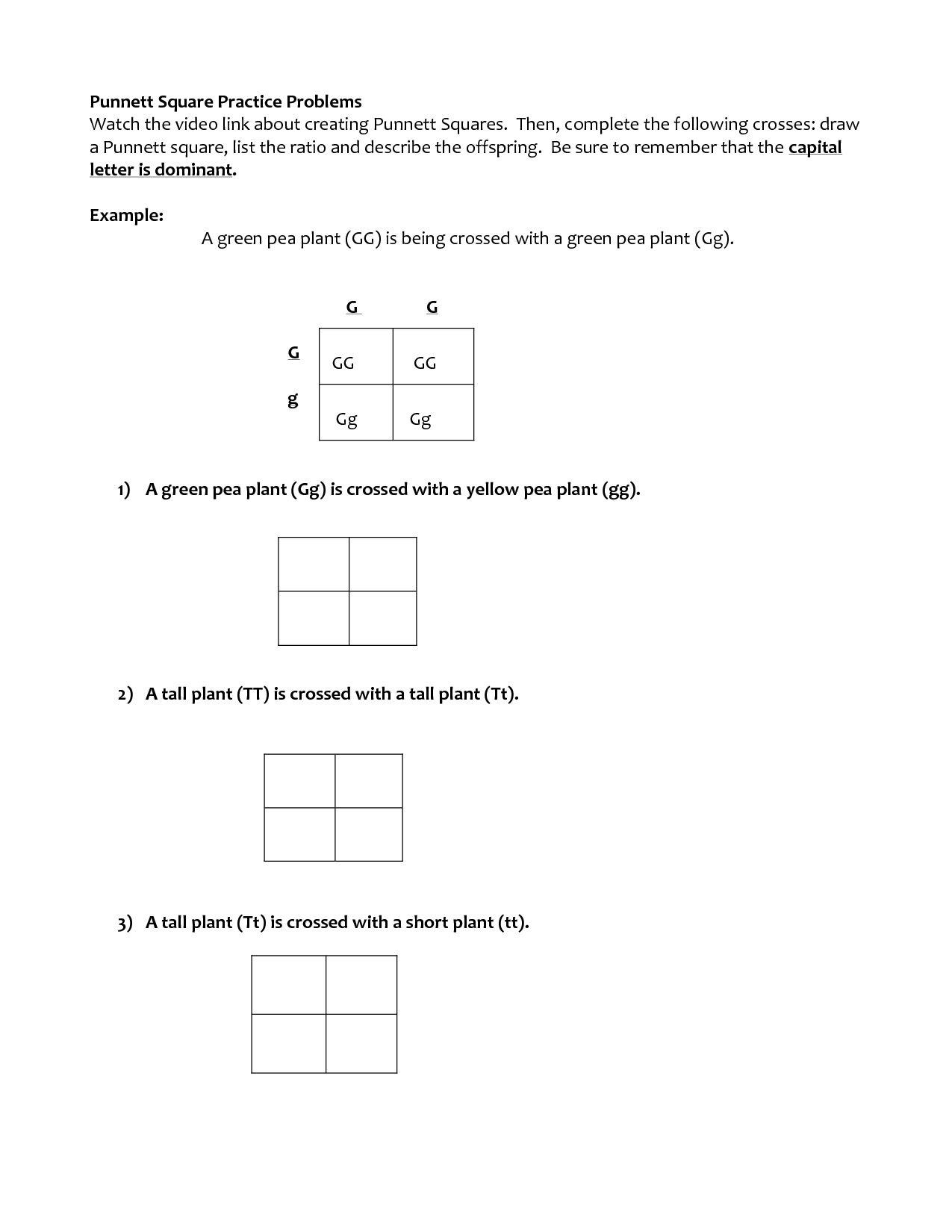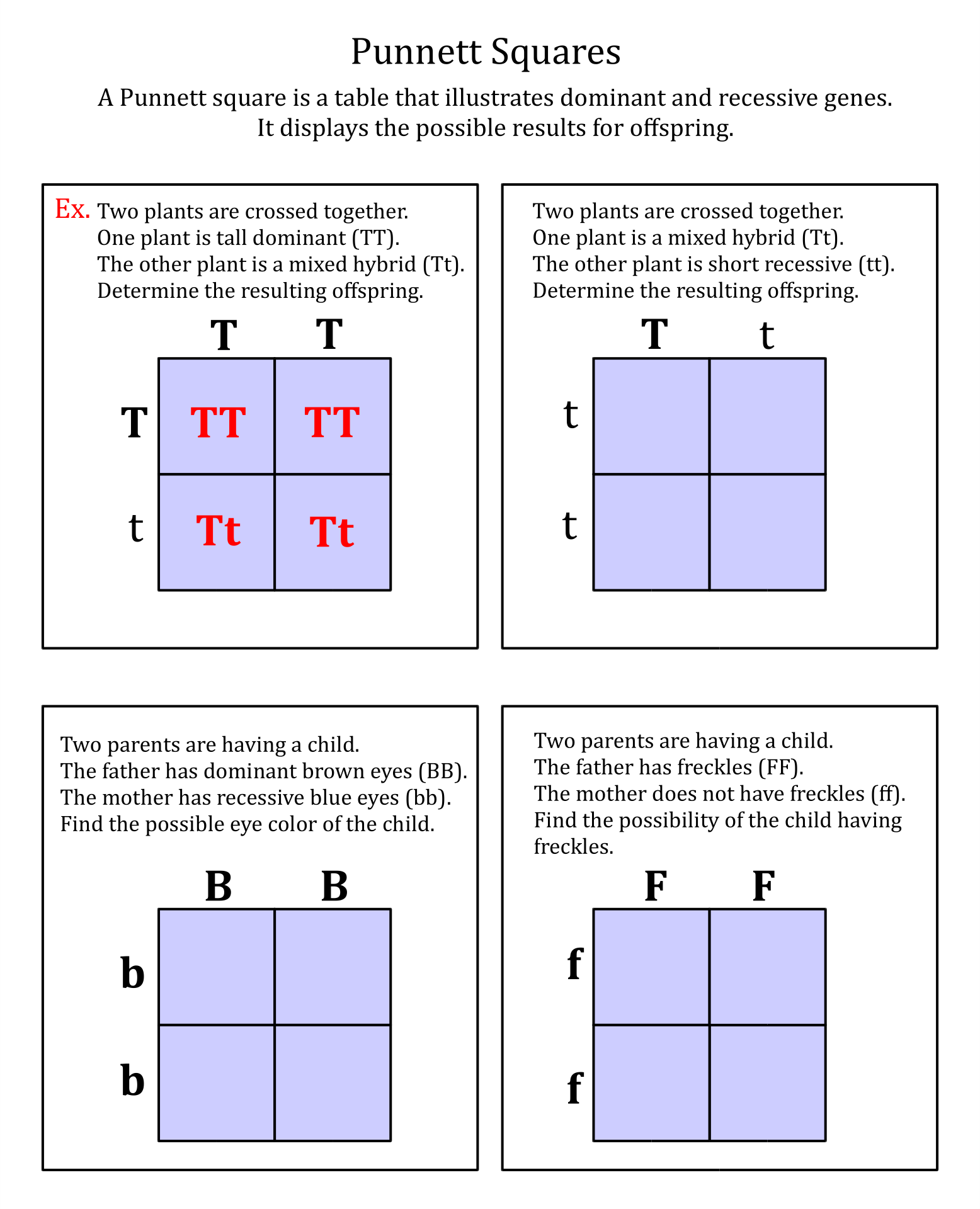Imagine a world where predicting the eye color of your future children was as simple as solving a puzzle. With Punnett squares, you can! These handy diagrams are the secret weapon of geneticists, allowing them to predict the possible genotypes and phenotypes of offspring based on the parents’ genetic makeup. Whether you’re a student tackling genetics for the first time or someone curious about how traits are passed down, this guide will make understanding Punnett squares a breeze.

Image: printablezoneklaudia.z19.web.core.windows.net
But what exactly is a Punnett square, and why should you care? Put simply, a Punnett square is a visual representation of a cross between two individuals, helping you determine the probability of their offspring inheriting specific traits. This tool is invaluable in various fields, including medicine, agriculture, and even evolutionary biology. So, if you’re ready to master the art of genetics prediction, let’s dive into the world of Punnett squares!
Understanding the Basics of Genetics
Before we delve into the intricacies of Punnett squares, it’s essential to grasp the fundamentals of genetics. Our DNA, the blueprint of life, is made up of genes, which are segments of DNA that carry instructions for specific traits. These traits can range from eye color and hair texture to more complex characteristics like disease susceptibility.
Genes and Alleles: The Building Blocks of Traits
Each gene comes in different forms, called alleles. Think of alleles as variations on a theme, dictating subtle differences in a trait. For instance, the gene for eye color can have an allele for brown eyes and another for blue eyes. Each individual inherits two alleles for every gene, one from each parent. This is where the magic of Punnett squares comes in! They help us predict which combination of alleles an offspring will inherit.
Dominant and Recessive Alleles: The Power Play
Not all alleles are created equal! Some are dominant, meaning they’ll always express their trait if present, while others are recessive, only expressing their trait if paired with another copy of the same recessive allele. Let’s revisit the eye color example: if a person inherits one allele for brown eyes (dominant) and one for blue eyes (recessive), they’ll have brown eyes because the dominant allele masks the recessive one. However, they still carry the recessive allele, which can be passed on to their children.

Image: www.printablee.com
Phenotype vs. Genotype: The Visible and the Hidden
It’s important to distinguish between phenotype and genotype. Phenotype refers to an individual’s observable traits, like blue eyes or brown hair. Genotype, on the other hand, represents the underlying genetic makeup for a particular trait, expressed in terms of alleles. So, while an individual may have the phenotype of brown eyes (observable characteristic), their genotype could be homozygous dominant (BB) or heterozygous (Bb).
Mastering the Punnett Square: A Step-by-Step Guide
Now that you’ve got the basics down, let’s construct a Punnett square to predict offspring traits. Imagine we’re studying flower color, with red flowers (R) being dominant to white flowers (r):
1. Define Your Parents:
We’ll use two parent plants: one with a genotype of RR (homozygous dominant for red flowers) and the other with rr (homozygous recessive for white flowers). This is the simplest scenario, but as you practice, you can move onto more complex examples with heterozygous genotypes.
2. Set Up the Square:
Draw a 2×2 square. On the top row, write the alleles of one parent (in our case, R and R). In the first column, write the alleles of the other parent (r and r).
3. Fill in the Boxes:
Now for the fun part! Take the first allele from each parent and put it into the corresponding box in the square. For example, the top-left box would have the combination “Rr”. Continue filling in the rest of the boxes:
| R | R | |
|---|---|---|
| r | Rr | Rr |
| r | Rr | Rr |
4. Interpret the Results:
The Punnett square now reveals the possible genotype combinations for the offspring. In this case, all offspring have the genotype “Rr”, making them heterozygotes. Since red flowers (R) are dominant to white flowers (r), all offspring will have red flowers, even though they carry the recessive allele for white.
Punnett Square Practice Worksheet: Putting Theory into Action
Here’s a practice worksheet using the same flower color example to solidify your understanding:
Worksheet
Parent 1: RR (Red)
Parent 2: rr (White)
Genotype of Offspring:
| R | R | |
|---|---|---|
| r | ||
| r |
Phenotype of Offspring:
Answers:
Genotype of Offspring:
| R | R | |
|---|---|---|
| r | Rr | Rr |
| r | Rr | Rr |
Phenotype of Offspring:
- All offspring will be red (Rr)
Beyond Basic Genetics: Exploring Complex Traits and Applications
Punnett squares aren’t just limited to simple traits like flower color. They can be used to analyze more complex inheritance patterns, involving multiple genes or traits influenced by environmental factors. This opens up a vast array of applications in various fields:
1. Medical Genetics: Predicting Disease Risk and Counseling
Punnett squares are invaluable tools for genetic counseling, helping individuals understand their risk of inheriting certain diseases. By analyzing family history and genetic testing results, counselors can estimate the probability of passing on disease-causing alleles to their offspring. This provides families with the information and support needed to make informed family planning decisions.
2. Agriculture: Breeding for Desired Traits
Farmers and breeders use Punnett squares to carefully plan their breeding strategies, aiming to enhance desirable traits in crops and livestock. By understanding the inheritance patterns of traits like yield, disease resistance, and nutritional content, breeders can select parent plants or animals with the highest probability of producing offspring with the desired features.
3. Evolutionary Biology: Tracing Genetic Lineage and Adaptation
Punnett squares play a pivotal role in understanding evolution, particularly when studying population genetics. By analyzing allele frequencies in a population over time, scientists can infer how populations change and adapt to their environments. This information helps us understand the history of life on Earth and predict how species may evolve in the future.
Punnett Square Practice Worksheet With Answers
Exploring Further: Resources for Continued Learning
This guide has provided a starting point for exploring the fascinating world of Punnett squares. However, there’s still so much more to uncover! To delve deeper into this topic, consider these excellent resources:
- Online Interactive Punnett Square Generators: Numerous websites offer online tools that let you create and analyze Punnett squares based on different inheritance patterns and genotypes.
- Khan Academy Genetics Videos: Khan Academy offers clear and engaging video tutorials covering various genetics concepts, including Punnett squares.
- Genetics Textbooks: For a more comprehensive understanding, explore introductory genetics textbooks that delve into complex inheritance patterns, genetic disorders, and biotechnology.
- Local Science Museums and Educational Institutions: Many science museums and educational institutions offer exhibits or workshops on genetics and heredity, allowing you to explore these concepts in a hands-on and interactive way.
By understanding Punnett squares and their applications, you’ll gain a deeper appreciation for the complex and fascinating world of genetics. So, embrace the challenge, practice your skills, and embark on your journey to become a master of genetics prediction!






